Abydos
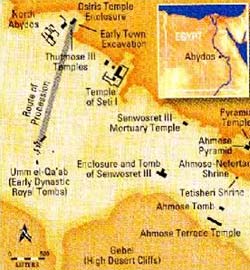 Abydos,
or Abjdu, lies in the eight nome of Upper Egypt, about 300
miles south of Cairo, on the western side of the Nile and
about 9.5 miles from the river. It spreads over 5 square miles
and contains archaeological remains from all periods of ancient
Egyptian history. It was significant in historical times as
the main cult center of Osiris, the lord of the netherworld.
At the mouth of the canyon at Abydos, which the Egyptians
believed to be the entrance to the underworld, one of the
tombs of the 1st dynasty kings was mistaken for the tomb of
Osiris, a thousand years later, and pilgrims would leave offerings
to the god for another thousand years. The area is thus now
called Umm el Qa’ab, "Mother of Pots." Abydos was the burial
place for the first kings of a unified Egypt. But it contains
remains from earlier, in the Predynastic period. In 1900 the
Predynastic cemetery of el-Amra was excavated with hundreds
of graves from all Predynastic phases. Other important cemeteries
were found at Naga ed-Deir, el-Mahasna, Mesheikh, Beit Allam
and the various cemeteries at Abydos itself. In addition,
settlements have been found, most representing small farming
villages. El-Mahasna had beer-brewing facilities.
Abydos,
or Abjdu, lies in the eight nome of Upper Egypt, about 300
miles south of Cairo, on the western side of the Nile and
about 9.5 miles from the river. It spreads over 5 square miles
and contains archaeological remains from all periods of ancient
Egyptian history. It was significant in historical times as
the main cult center of Osiris, the lord of the netherworld.
At the mouth of the canyon at Abydos, which the Egyptians
believed to be the entrance to the underworld, one of the
tombs of the 1st dynasty kings was mistaken for the tomb of
Osiris, a thousand years later, and pilgrims would leave offerings
to the god for another thousand years. The area is thus now
called Umm el Qa’ab, "Mother of Pots." Abydos was the burial
place for the first kings of a unified Egypt. But it contains
remains from earlier, in the Predynastic period. In 1900 the
Predynastic cemetery of el-Amra was excavated with hundreds
of graves from all Predynastic phases. Other important cemeteries
were found at Naga ed-Deir, el-Mahasna, Mesheikh, Beit Allam
and the various cemeteries at Abydos itself. In addition,
settlements have been found, most representing small farming
villages. El-Mahasna had beer-brewing facilities.
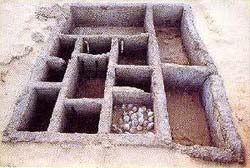 The
Predynasty/Early Dynastic cemetery is located in the low desert.
It consists of three parts: predynastic Cemetery U in the
north, Cemetery B in the middle with royal tombs from Dynasty
0 and the early 1st Dynasty, and in the south the tomb complexes
of six kings and one queen from the 1st dynasty and two kings
from the 2nd dynasty. Most of the 1st dynasty tombs show traces
of immense fires. Many had also been plundered many times.
The
Predynasty/Early Dynastic cemetery is located in the low desert.
It consists of three parts: predynastic Cemetery U in the
north, Cemetery B in the middle with royal tombs from Dynasty
0 and the early 1st Dynasty, and in the south the tomb complexes
of six kings and one queen from the 1st dynasty and two kings
from the 2nd dynasty. Most of the 1st dynasty tombs show traces
of immense fires. Many had also been plundered many times.
In 1977 a tiny ivory label was discovered
bearing the "nar" name of Narmer, and the king is seen smiting
an enemy in the Delta.
Cemetery U contains several hundred
graves and offering pits. Ceramics are from the Naqada culture.
Of particular importance is the tomb named U-j, uncovered
in 1988. It is dated to 150 years before Aha and the beginning
of the 1st dynasty.
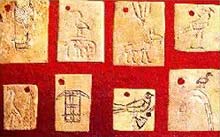 The
tomb is elaborate, brick-lined, with doors and windows. It
has twelve chambers and measures about 27 feet x 24 feet.
It still contained much funerary equipment. There were large
amounts of different kinds of Egyptian pottery, and more than
200 wine jars imported probably from Palestine. There were
also about 150 labels of ivory or bone, many of which were
apparently attached to linen bolts.
The
tomb is elaborate, brick-lined, with doors and windows. It
has twelve chambers and measures about 27 feet x 24 feet.
It still contained much funerary equipment. There were large
amounts of different kinds of Egyptian pottery, and more than
200 wine jars imported probably from Palestine. There were
also about 150 labels of ivory or bone, many of which were
apparently attached to linen bolts.
Many of the inscriptions on the labels
are readable with clear glyphs and signs. The most frequent
sign was a scorpion, sometimes together with a plant. It is
speculated that either King Scorpion was buried here or that
he was a known figure. Hundreds of wine jars imported from
Canaan were also unearthed in one of the tomb’s store-rooms.
There were traces of a wooden shrine
on the floor in the burial chamber, and in the northeastern
corner a complete crook-shaped scepter of ivory.
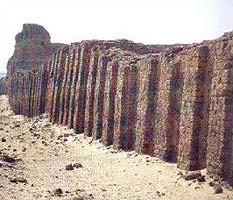 Many
of the earliest tombs are in the location known as Umm el
Ga'ab. Ten royal enclosures in total must have been built;
but only eight have been located. Some of the royal owners
have been identified: Djer, Djet (Tomb), Queen-mother Merneith
(Tomb), of the 1st Dynasty, Den (tomb) and Peribsen (Tomb)
and Khasekhemwy (Tomb)of the 2nd Dynasty. At least some of
these burials were surrounded by subsidiary graves for attendants
killed and buried along with the royal funeral.
Many
of the earliest tombs are in the location known as Umm el
Ga'ab. Ten royal enclosures in total must have been built;
but only eight have been located. Some of the royal owners
have been identified: Djer, Djet (Tomb), Queen-mother Merneith
(Tomb), of the 1st Dynasty, Den (tomb) and Peribsen (Tomb)
and Khasekhemwy (Tomb)of the 2nd Dynasty. At least some of
these burials were surrounded by subsidiary graves for attendants
killed and buried along with the royal funeral.
Cemetery B contains three double-chamber
tombs, currently attributed to King Aha (Tomb), and his Dynasty
0 predecessors of Narmer (tomb), Ka (tomb) and possibly another
King named Iry-Hor (tomb). Pottery shards have been found
here which are inscribed with the name-signs of these kings.
Royal graves at Abydos became more
elaborate, until the last and largest royal tomb built there
for Khasekhemwy, last king of the 2nd Dynasty. His tomb, called
Shunet es-Zebib, the Storehouse of the Flies, measures about
230 feet long and varying between 56 and 33 feet in width.
Near Khentyamentiu’s temple, a mile north of the Umm el Ga’ab
(Qa'ab) cemetery and nested among the enclosures were fourteen
(found to-date) large boat graves The remains of the ancient
ships, dating to the 1st Dynasty, were uncovered in the desert.
Each averages 75 feet in length and had been encased in a
structure two-feet thick with whitewashed mud-brick walls.
Whether they were meant to represent solar barques, anticipating
the ship built by Khufu and found within his Pyramid at Giza,
is not yet known.
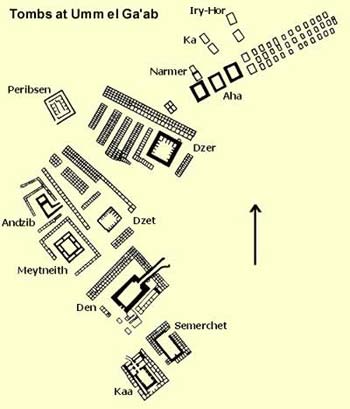 North
Abydos contains an ancient settlement and also the remains
of a large stone temple from the 30th Dynasty, along with
a portal structure of Ramesses II, and a fairly recently discovered
temple built by Tuthmosis III. Most of the early town lies
beneath modern groundwater and the remains of later settlements.
Another temple, that of Khentyamentiu which was later identified
with Osiris as his temple, dates from the later third millennium
BCE. Royal cult buildings or ka chapels were built here by
kings from the Old Kingdom through the New Kingdom. Buildings
to the west and southwest of the cult buildings proved to
be houses spanning the period from late Predynastic to the
2nd Dynasty.
North
Abydos contains an ancient settlement and also the remains
of a large stone temple from the 30th Dynasty, along with
a portal structure of Ramesses II, and a fairly recently discovered
temple built by Tuthmosis III. Most of the early town lies
beneath modern groundwater and the remains of later settlements.
Another temple, that of Khentyamentiu which was later identified
with Osiris as his temple, dates from the later third millennium
BCE. Royal cult buildings or ka chapels were built here by
kings from the Old Kingdom through the New Kingdom. Buildings
to the west and southwest of the cult buildings proved to
be houses spanning the period from late Predynastic to the
2nd Dynasty.
A residential and industrial section
have also been found to the southeast of those excavations,
dating to the Old Kingdom and First Intermediate Period. A
number of mudbrick houses, consisting of between 7 and 10
small rooms, courtyards and a narrow street have been found.
A workshop, the earliest and most complete faience workshop
in Egypt, was also uncovered, complete with kilns.
The Northern cemetery was the principal
burial ground for non-royal individuals at Abydos during the
Middle Kingdom, and continued to be so used through the Graeco-Roman
period.
The tombs of the first kings of unified
Egypt were deep brick-lined structures topped with mounds
of sand, later called mastabas, the Arabic word for bench,
since their square or rectangular shapes resembled benches.
Later in the 1st Dynasty, one structure was placed underground,
supported by a retaining wall, and the second mastaba was
placed above ground directly over the first, to protect the
lower one.
The most striking standing buildings
are the enclosure of King Khasekhemwy from the 2nd Dynasty,
the well-preserved New Kingdom temples of Seti I (temple)
and Ramesses II (temple) from the 19th Dynasty, and the walled
enclosure now called the Kom es-Sultan, the location of the
early town and main temple dedicated to Osiris.
The 19th Dynasty Seti temple contains
seven sanctuaries set in a row, each dedicated to a different
deity, Ptah, Ra-Harakhty, Amun-Ra, Osiris, Isis and Horus.
Seti I himself was included with his funerary shrine. The
unusual L-shaped plan of the temple is caused by a southeast
wing appended to the main rectangular-shaped temple. This
wing contains rooms dedicated to Sokar and Nefertum and other
funerary deities. There is also a King list to the south of
the sanctuaries. Since the temple was unfinished when Seti
died, his son and successor Ramesses II finished the work.
Immediately behind the chambers dedicated
to the Osiris cult is another structure, subterranean, called
the Osireion. It contains offering scenes and other scenes
from the Book of Gates and the Book of the Dead.
South Abydos was developed as a zone
for royal cult complexes, two well-preserved ones so far identified
as belonging to Senusret II of the 12th Dynasty and Ahmose
of the 18th Dynasty, who built a small pyramid here. .
Relief fragments at the complex of
King Ahmose, the founder of the New Kingdom and conqueror
of the Hyksos invaders, have been found near his pyramid and
funerary complex at Abydos. One fragment represents a group
of three arcers, teams of bridled chariot horses, ships with
oars, and fallen warriors recognizable as Asiatics. Other
fragments bear the names of Apophis, the leader of the Hyksos,
and that of Avaris, the capital city of the Hyksos.
As work proceeds at ancient Abydos,
a home of the dead for so many millennia, more and more of
the history and religious beliefs of the ancient Egyptians
is returning to life.